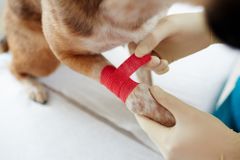
From choking on foreign objects to sustaining a cut, animals can experience many of the same emergency health problems as humans. While these events are overwhelming, how you respond can prevent additional health problems from occurring and may even save your pet’s life. If you need to take your companion to the veterinarian for emergency care, here are five first aid tips that can help protect your pet beforehand.
How to Care for Your Pet With Basic First Aid
1. Keep a Stock of First Aid Supplies
Similar to a first aid kit for people, your pet’s emergency supplies should contain gauze to wrap wounds, milk of magnesia to absorb poison, disinfectant to sterilize wounds, a muzzle to secure your pet’s head, and a small stretcher to stabilize the body for transport. Keep emergency contact numbers in your phone and the kit for easy access.
2. Clean & Dress Wounds With Care
 Cleaning a cut, scrape, or burn can prevent it from getting infected. If possible, first wash the affected area, then treat it with a disinfectant such as hydrogen peroxide. If the wound is bleeding, apply pressure for at least three minutes until clotting occurs. Once bleeding stops, dress the wound in gauze and non-stick bandages.
Cleaning a cut, scrape, or burn can prevent it from getting infected. If possible, first wash the affected area, then treat it with a disinfectant such as hydrogen peroxide. If the wound is bleeding, apply pressure for at least three minutes until clotting occurs. Once bleeding stops, dress the wound in gauze and non-stick bandages.
3. Promptly Respond to Poisoning
If your pet has ingested poison, a dangerous plant, or toxic food, call (888) 426-4435 to reach the Animal Poison Control Center. This 24-hour hotline will provide instructions on how to treat the poison, such as by inducing vomiting, flushing eyes or skin, or providing drinking water. As you take these emergency steps, prepare your pet to visit the veterinarian.
4. Know How to Perform Rescue Breathing
If a foreign object is restricting your pet’s breathing, carefully try to pull it out without pushing it further down the throat. If the animal is not breathing at all, provide chest compressions and rescue breathing until you can get help from a veterinarian. More details on how to safely perform CPR are available through the American Veterinary Medical Association.
5. Transport Gently
Whether your companion has suffered from a fracture, head injury, or severe cut, you need to move them carefully to avoid causing additional harm. Unless the animal is vomiting, first secure their head with a muzzle. If they have a physical injury, secure the body to a flat board or stretcher, so your pet can be gently transported to the veterinarian.
If you require emergency animal care in Hilo, HI, turn to the specialists at Maka‘i Veterinary Clinic. Providing 24-hour emergency assistance, these veterinarians will address everything from burns and breathing problems to fractures and poisoning. Equipped with advanced resources like stem cell and laser therapies, this clinic will provide expert care to protect your pet. Learn more about their capabilities online, and call (808) 959-2273 to make an appointment.
About the Business
Have a question? Ask the experts!
Send your question

